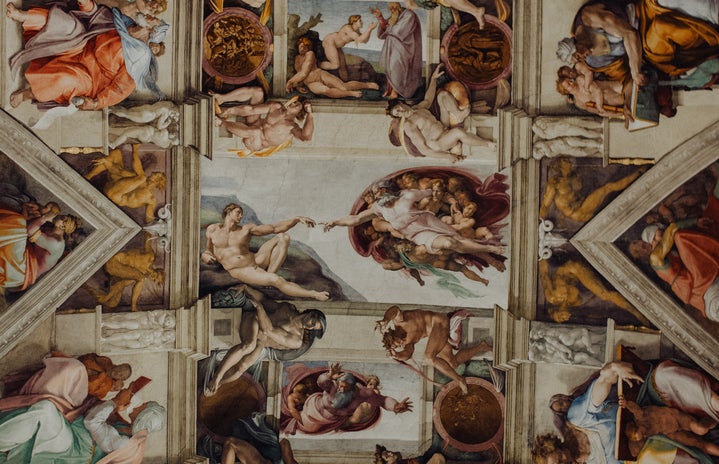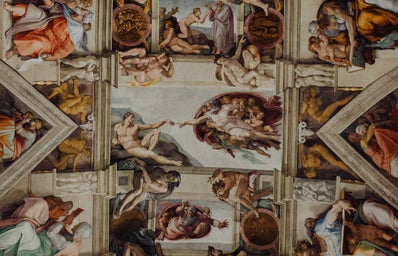To learn about history, more than just a wordy textbook is needed. Visual history details a deep understanding of why people of our past acted the way they did. It explains the emotions behind reason, a foreshadowing to revolutions and wars, as well as allowing a critical analysis of events both known and unknown. Art has been a part of history since the human race started, and since then has had a grand role. From the cave paintings in France to the political cartoons of World War II, all the way to the discussion of why a banana taped to a wall is art (it’s not), art has been necessary to the human race’s understanding of each other.
Art history has always been my favorite subject, it’s easy for me to grasp and fascinating to read. As a painter, I have always veered towards storytelling in European paintings during and after the Renaissance. And, taking an Italian Renaissance class has only made me more inclined to share my favorites of Europe. Here are three of my all-time favorite paintings, along with the what and the why.
- Jean-Honoré Fragonard, The Swing
-
The Rococo period was famously known for its lavish pastel colors, playful notions, and regal nobility. Balls, gowns, and powdered wigs featured the bourgousies’ everyday lives. The art during this 18th-century period was no different, and artists like Fragonard painted a lasting legacy. This painting is one of my absolute favorites, instantly eye-catching, and incredibly fun. The subject alone differs from past paintings, like the Renaissance, or Baroque art. She is mid-motion, stuck in the air in a lovely pink gown, elegant yet cheeky as her socks and underdress peek out. Even her shoe moves, flinging off her feet and into the air!
As she swings in a garden every green thumb wishes they had, two other characters melt into the background. With a closer look, two men appear: one young, one old. This is where the unexpected scandal starts. The old man clutches the reigns of this rope swing, pushing her and subjected to shadow. Supposedly, this is her husband, in the manner of an arranged marriage and family standings. The rope suggests control, as there was little freedom a French noblewoman could find herself with. Despite this however, she hides a young man in front of her in the grass, unbeknownst to her husband — the mistress, if you will. The affair is forbidden yet flirtatious and full of youth. The risk portrayed is what makes this piece live and breathe, and I as a viewer was caught by the cumbersome situation, wondering if this was one moment of a fully fledged story, caught on one canvas.
The subject matter wasn’t unseen by the period. Rococo solidified itself in history as opulence before the storm. In other words, the luxurious lifestyle portrayed in lush pinks and greens was an eclipse in time, before the fall of nobility and the start of the revolution. Think of Marie Antoinette, who was coated in jewels and gowns in Versailles right before her infamous execution. There is ingenuity in Fragonard’s iconic representation of lighthearted aristocrats, which I appreciate for both its aesthetics and hidden meanings.
The art history website SmartHistory has an incredibly detailed interpretation of this painting, with allegories and metaphors galore. I highly suggest watching if art history interests you!
- Johannes Vermeer, Girl with a pearl earring
-
When discussing art history, it’s hard not to bring up Girl with a Pearl Earring. As SmartHistory details, it is a painting only recently made famous, and often compared with Leonardo DaVincis’ Mona Lisa. It is not a portrait of a person, but instead the representation of a human archetypal, with mysterious and historically interpretive dress. Her gaze is piercing and real, with glowing eyes that fit her face perfectly. As she sits on a black background, the full focus is on her, as she is in the middle of turning her body and speaking to us, the viewer. It has a personality and is also quite personable. The colors chosen are incredibly rich despite having an air of subtlety, and all melt together as the composition casts light on her face.
Dutch artist Johannes Vermeer created this painting during the country’s Golden Age, roughly the 17th century. This era was the country’s peak in art, science, math, and discovery, cultivated through curiosity. In a world post-Renaissance, artists found a new precedent set by DaVinci and Michelangelo. This included sfumato and chiaroscuro. Sfumato is described as the smokey appearance of blended paint, used to create soft contours and natural lines. It was a staple of DaVinci’s work, especially the Mona Lisa, and is also visible in Girl with a Pearl Earring. Her cheek and nose contour are soft in nature and flow smoothly. It is realistic, it feels alive. The second technique coined in the Renaissance was chiaroscuro. Later seen in Baroque art by artists like Caravaggio, this way of layering color is described by the use of contrasting dark darks and light lights. Under the subject’s neck is a sharp dark shadow, and the back of her neck gets lost in the background. Yet as the viewer, we still know it’s there because of the implied lines chiaroscuro offers.
This painting is proof of the growth of art, as the canvas becomes a three-dimensional window into space, with a girl watching you, the viewer. SmartHistory once again offers a short video on the relevance and spectacular nature of the painting, one that is almost indescribable.
- Raphael, The school of athens
-
For my last iconic piece, I have chosen Raphael’s School of Athens, otherwise known as Philosophy. This might be one of my favorites, contextually enriching with fascinating history. This 16th-century Italian Renaissance painting signals the turn of the century and the Renaissance itself.
Before the era of Raphael, Donatello, Michelangelo, and Leonardo DaVinci, there was the era of Giotto, Cimabue, and Duccio. The true start of the Renaissance, a rebirth of Greek and Roman antiquity in 13th-century Italy. A reach to remake ancient Roman architecture, and paintings, all with a newly Christian twist. As the era of the Renaissance came to be, Christian orders like the Franciscans and the Dominicans came to be. They each had their own interpretations of the bible, religion, and its teachings. They strived to paint these subjects with the respect that ancient Rome painted its gods and goddesses. The Virgin Mary, Jesus, and God the Father became the icons of altarpieces and ceiling frescos, and the only way to become a citizen in Italy was to forfeit your own religion to Christianity.
Florence was one of the most quintessentially Renaissance cities of the early era. Rome, on the other hand, was suffering. The fall of the Roman empire had left the city in a dumpster fire, knocked down from its former glory. It wasn’t until the papacy decided to uplift the city and make it great once again in the 15th century that it started its steps back up to historical greatness. As Rome revitalized its buildings and established its following of Saint Peter, the Pope recruited artists from known cities like Florence and Milan as court artists. The Roman papacy wanted a shift, with not only religious greatness but academic excellence. The philosophy of ancient Greece and Rome was respectable and deserved the same worship that religion had gotten for centuries. Pope Julius II commissioned young Raphael to paint his library with the four wisdoms of the time: theology, music, poetry, and of course, philosophy. This is why the School of Athens is so fascinating, as religion and academics stood across from each other as frescos in the same room, at the same level of importance.
The actual context of the painting features Plato and Aristotle in the center of a fictive architectural temple that mimics ancient Roman temples. Plato, the mentor, and Aristotle, the student, engage in conversation. With his hand lifted to the sky, Plato is assumed to be discussing his ideologies. It is known he theorized about that above the realm of the physical. Aristotle, though, disagreed with his teacher. His hand points to the ground, symbolizing his belief in the philosophy of what is in front of him, consisting of earthly positions. Raphael smartly portrays this intellectual divide in his composition, referencing other philosophers like Pythagoras (discussing how math may ascend the limits of our reality — platonic thoughts to their core) and Euclid (teaching students his finding of geometry, physical math that matches Aristotle’s ideologies). Each ancient philosopher stands to the side of history they agree with, emphasizing that infamous battle of brains.
School of Athens is unique in the way Raphael references multiple famous artists of the time. Historians believe multiple of the philosophers on this fresco also represent artists like Michelangelo and Leonardo DaVinci. In doing so, he compares the famous artists of the time to the thinkers of the ancient Roman/Greek period — great in all similar areas. The Renaissance is a period of praise and belief in art as more than a talent, but an important setting of history. As an artist myself, paintings like these make me proud to see the influence and fame art has had on all of history.
SmartHistory’s video of this incredibly introspective piece of art is fascinating. The emotional intelligence of the high Renaissance truly shines in Raphael’s School of Athens.
These three paintings only brush the surface of an affluent culture of art. Asian ceramics and ink drawings, African textiles and vessels, South American tapestries and murals, and American Indigenous and contemporary art, all have their world of art. European paintings are only one of the many ingenious works of art that have been created over the 300,000 years of human history. In fact, most of the Italian Renaissance in Venice and Siena was influenced by the silk trade and trips to and from Asian and Islamic cities, and Constantinople turned Istanbul. Every one of my aforementioned paintings has a history beyond Europe, which is what makes art history so special and unique. It is a form of connecting the human race together, in the simplest form of creative pleasure. Art history matters so much more beyond pretty images, but even pretty images are reason enough for this form of history to have an impact. Humanity is what it is because of art history, and every piece of art history has a story worth learning.


